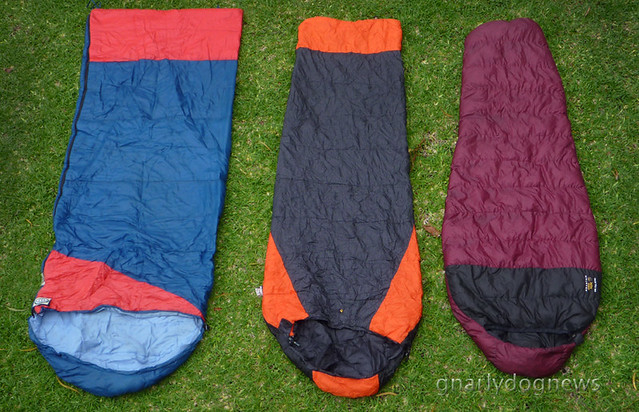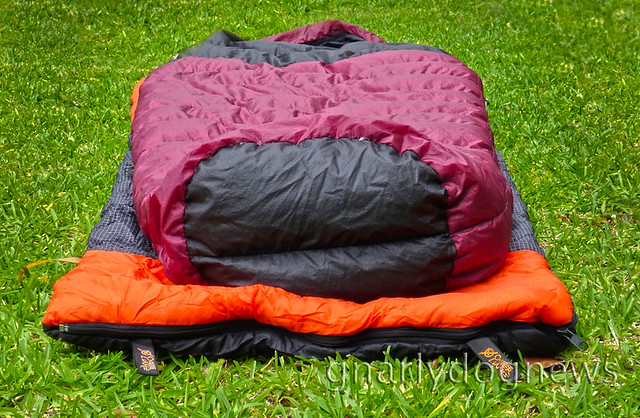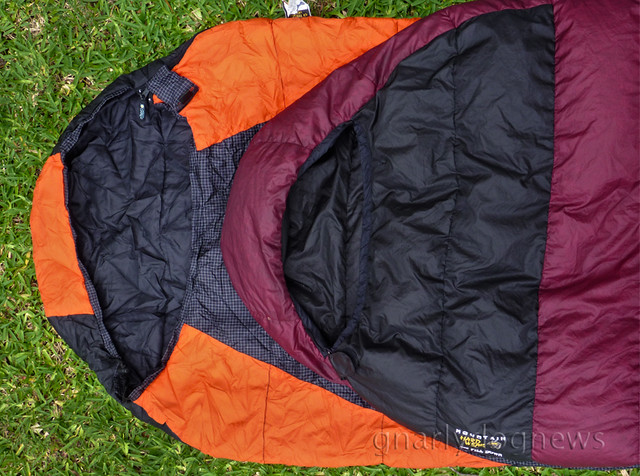I have been enjoying camping in remote locations for a few decades and most times I have provided my own shelter and bedding.
One item that I regard essential for good nights sleep is a suitable sleeping bag.
Second to some form of shelter (not always) the sleeping bag is probably the one item that can make my sleep enjoyable.
Even on very minimalistic trips I have never left it behind.
I have owned countless sleeping bag and currently I have 9 in my wardrobe.
Incidentally all of those sleeping bags are down filled.
I don't own a single synthetic one.
Why?... a couple of reasons.

3 packed-up bags: synthetic (warm-ish), synthetic (cold-ish) and down (warm). Coke can for sizing
When I first started camping (motorcycle days) I was given a synthetic sleeping bag as a present.
Having never owned one before, I was stoked.
It kept me warm at night and that was it.
So why don't I have one now?
My new synthetic sleeping bag was admittedly a bit bulky and used to take up a lot of room on the back saddle of the motorcycle.
With time it became much easier to compress it in the factory storage bag provided.
I thought I was getting good at compressing it but also noticed that it no longer kept me warm on cold night.
My once greatly lofting sleeping bag was now sagging and became thin, all in the short time of about a year.
Eventually I gave up twisting throttles and enjoyed backpacking (bushwalking) more.
My synthetic sleeping bag engulfed half of the space available inside my enormous backpack.
After a couple of outings with experienced bushwalkers I soon realized that synthetic sleeping bags just are not compact nor warm; the other guys all had down filled sleeping bags.

same sleeping bags as in previous photo: out of their compression bag
A down sleeping bag was my next purchase.
I then discovered the other great benefits of a down sleeping bag.
For the same temperature rating my down sleeping bag also weighted half as much.
Much more compact an much lighter: I really liked that.
I also realized that a down sleeping bag had a wider comfort temperature range meaning that it was not too hot during mild nights and still warm enough when the temperature dropped.
It's the natural ability of the tiny down plumes to regulate the comfort level of the sleeper.
Being a natural product down breathes better and will let body moisture escape through the fill better than synthetic.
My down sleeping bags don't suffer from loft loss like my synthetic bag did.
I have one bag that's probably 17 years old and I still use it for the same conditions as when it was new.
If not abused down will really last a long time.
In this comparison I have depicted 3 sleeping bags: two synthetic ones (borrowed) and one down one.
The maroon/black colored one is the down one.
Incidentally is also the warmest.
If size matters (or lack thereof) the photographs speak for themselves.
Just like with my sleeping mats: less is more.

While there is no significant size difference between the bagged (compressed) synthetic bag in the black sack and the down in the orange one, now notice below the two bags out of the compression sack.
The synthetic one offers very little insulation resulting in a comfortable sleep only during warm nights.

The synthetic bags are also much wider in the feet area.
Some might think that a bit roomy is good in balmy conditions, it becomes cold comfort when the sleeping bag should keep you warm.
Despite what technical claims will try to sell you, a sleeping bag is efficient when it traps the body heat provided by the occupant.
And to date there is no better practical insulator than non circulating air.
By lofting down creates a chamber where the air does not move. The thicker this chamber is the warmer the bag.
Furthermore the sleeping bag should prevent the escape of the warm air created by your body.
A wide hood will be unable to trap this warm air and a sleeping bag without a hood is only suitable for mild temperatures.
In essence, to be warm, a sleeping bag should have:
-decent thickness (loft)
-a fitted hood (preferably 3 dimensional)
- a narrow foot area
There are many other additional features that will make a bag even better, but should not lack the above ones.

My pictorial comparison is however biased.
The down sleeping bag is a high end one with 800 loft down, close cut, body contoured.
The synthetic ones are entry level offerings from discount stores.
The price difference is substantial but considering that a well looked after down bag will really last you for years, it probably evens out.
There are better synthetic sleeping bags out there but, in my experience, none come close to the performance of down.
The argument that a wet synthetic sleeping bag will keep you warmer than a down one doesn't fly with me.
I wish to never have to sleep in a wet bag, down or synthetic.
All sleeping bags should be protected in a dry bag where getting it wet should not be an issue.
In twenty five years of camping I am yet to experience a shelter leaking enough to really wet my bag and warrant the use of a synthetic one.
Sure, there are some extreme cases where maybe a synthetic bag would be a better choice; It just does not happen around my part of the woods or stretch of coast :-)
Last but not least: cheap, good... pick one.
Down sleeping bags vary a lot in price. It is worth doing a bit of homework before heading to your favorite retailer. There is a lot of good info/reviews available on line; try to avoid the ones that are commissioned by one manufacturer :-)

I agree with you in general and I have made similar choices in my preference to down. However, let's be advocate for synthetic for a short while:
ReplyDeleteIf you expect to camp in wet weather a lot on consecutive nights (not a weekend warrior) then you need to realize that it might take a good deal of care and luck to keep your down sleeping bag dry. Even if you never exposed your down bag to dripping water the amount of body perspiration during the night coupled with the amount of moisture in the air when camping during rainy weather will basically soak the down bag and there will be very little chance to dry it before your next night. Day by day miniscule mishaps will expose portions of your bag to being wet. All of these add up.
Of course if you are going out for a night or two (the usual weekend) then you will hardly experience this.
So, what to do - choosing synthetic for such trips might not be a bad idea.
Staying with down - you need at least use a VB liner to prevent your perspiration to incrementally soak your down sleeping bag.
Signed - the original SPOT dissing poster.
Spot Disser, (I like that :-)
ReplyDeleteyou have a valid point re down in a continuous wet environment.
On longer trips to very wet places (like New Zealand) we had to take a bit more care of our down bags.
But we had excellent tents that didn't leak, at all.
Obviously the bags were not just laying around in the tent when coming in all wet from the incessant rain; they were carefully put aside until we were changed into dry clothes.
I can see a synth bag useful where really it's wet all the time but luckily enough most of my outings are in sunny Queensland.
If wetting down bags could be an issue, there are waterproof shelled ones available (a bit heavier/more bulky).
In really cold environments (snow camping) down is king. I have never used anything else.
I don't think a polar expedition is on the cards for me (where prolonged freezing body vapor would kill any bag) so a VB won't be needed soon.
Thank you for pointing out the shortcomings of down though.
I've soaked a down sleeping bag before- but I'd had a lot of beer. I have since switched to a golite mummy sleeping bag and have been dry as a bone ever since.
ReplyDeleteEnjoyed the post,
Nordlander
Moral of the story: don't get down if you are a pisshead? :-)
ReplyDeleteSo, sleeping in a synthetic bag when you wet yourself is OK... there you go, learned something new.
I recently bought a modern synthetic bag, its rated to -15F and incredibly toasty. One point I do agree with is compressibility; without a doubt even the most modern synthetic bags do not compress as well as down bags. I estimate after compression I am looking at a 40% increase in size over the similarly rated down bag. Fortunately in my NDK explorer for the length of trips I tend to take 4-5 days, space has not been an issue, and price is.... For the cold weather bags rated for -15F there was a 3x price increase for down.... So yep down is better if money is no object.
ReplyDeleteThere is another point that nobody mentions.
ReplyDeletedown clotting.
It can happen on extended trips because of excessive persperation or breath, in the hood, upper chest, and footbox area. this will lead to down clots, which the only solution is to wash it and dry it.
Lets say I have a 3 pound 0 degree down bag. I have this problem. Well, the solution is to get a bivy. Lets face it, those 5 ounce bivys are NOT durable for long term, but lets say i get a 14 ounce Marmot Alpinist bivy.
NOW .. i have a 4 pound sleep system ... which is pretty close to a 0 degree SYNTHETIC, which by the way, i dont have to pamper, wont lose loft because of HUMIDITY, AND ... i can wash it and dry it REAL fast and easy. and i dont really need a bivy for either.
The truth is that people, especially in the winter, dont take into account their bivy if they are using one in conjuction with a tarp or even a tent and dont add it to the weight.
DOWN + BIVY = SYNTHETIC
if your not using a bivy .. you probably live in a dry climate. but go to the northeast or pacific west and try that on long term trips or live out of your backpack that way. good luck.
Also, what about when you wake up and you have dew or condensation on (and in) your down sleeping bag ... and its 7 degrees. cloudy. well, you throw it in your pack, and then what? well, it thaws out from your body heat against your back. where does all the WATER go ... YUP ... into the down.
Sure, perhaps at lunch, you can dry it out when it 15 degrees and sunny. Good luck with that. you see, this might not matter for one or two days, but after a while, it adds up, and when the high is below 20 degrees, and its windy .... it takes a whole lot of sun to dry you bag out even though you have NO CLUE that its wet. You cant tell its wet ... but it is.
the down will clump, and you will slowly have loft falure. not only that, but now, you have to wash your bag - NOT because it is dirty, but to get the clots out. that $40 and a whole day.
I used to be a huge down guy ... but i use my gear a lot. I LIVE out of it in most cases. And for someone like me, a down bag is just a bunch of worry, aggrevation, and $$$$ washing and drying it.
The compromise is to have a synthetic overbag and a 30-40 degree down inner bag. that works in most cases, but even then, i have had clotting in the down from exteneded exposure to persperation and humidity. But this works for the most part.
Personally, when i do the math, including a bivy ... the ONLY real downside to synthetics is bulk. and even that is slowly becoming better and better.
I am no expert nor live in my sleeping bag for extended periods of times; others do that.
DeleteI just see a lot of light-packing crowd and cold climate expeditioners use down sleeping bags for their extended adventures.
It has worked for me and so far for over 20 years of weekend warrior style outings and the occasional multi weeks trips. Of course we all have different skill levels and take care of our gear differently; I am glad that synthetic bags work for you.
I however don’t feel too comfortable to be sleeping out when it’s raining with nothing above my head and I always have a tent fly (or at least a decent tarp) to shelter myself and my bag from moisture.
It will be also interesting to see how the new “dry down” (waterproof treatment) holds up in real world tests.
Thank you for sharing your experience. I also like to use this synthetic sleeping bag when I go camping outdoors.
ReplyDelete